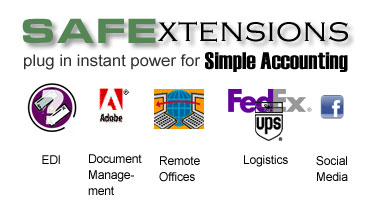 In this screen you enter and edit customer quotes and sales orders (including customer releases.)
In this screen you enter and edit customer quotes and sales orders (including customer releases.)
To get a better understanding of how to use Sales Orders we recommend you go to the Sales Order Workflow topic.
Like all browse screens in Simple Accounting, you enter and edit these orders by pressing the [Insert] and [Change] buttons.
Once an order is saved, an invoice can be printed. You may also accept payment directly from this screen for point-of-sale orders.
Orders which have not yet been invoiced may be edited freely. Once an order has been invoiced it may not be edited; however, it may be voided. When you void an invoiced sales order, you delete the line items, though the invoice remains.
Special Browse Columns
The first four columns of the browse are especially important:
| ! (Tagged) | Is the order tagged for batch printing of invoices, packing slips, quotes? If the order is tagged you’ll see a green check mark. | ||||||||||||||
| T | The Order Type. Possible values are:
|
||||||||||||||
| P | The Order’s Payment Status. If the order is invoiced, this indicates if the order is paid for or an open credit. This column is blank if the order has not yet been invoiced.
After invoicing, color is still used to indicate the payment status of the order (now invoice).
| ||||||||||||||
| S | The Order Status indicates the progress of the order from quote through billing. Simple Accounting also uses color to make it even easier to see the progress of each order. Sales Orders are displayed in various colors in this browse depending on where they are in the order cycle.
|
Tabs
The tabs are extremely important! They determine not only the order in which Sales Orders are displayed, but also which orders are displayed. The following tabs are available:
| Open Orders | Displays all open orders (no invoice) in Customer ID order. This includes all orders which are not yet billed, including Acknowledged and Shipped orders.
Search By: Typing a Customer ID. |
| Order ID | Displays all orders in Simple Accounting according to their
Search By: Typing an Order ID. |
| Name | Displays all orders in Simple Accounting according to their
Search By: Typing the Customers Name. The Customers most recent order will appear. |
| Invoice | Displayed all orders which have been invoiced. This includes Credit Memos, Voided Invoices and Summary Bills.
Search By: Typing the Invoice Number. The Customers most recent order will appear. |
| Open Invoices | Displays open invoices sorted by Customer ID.
Search By: Typing a Customer ID. The Customers oldest open invoice will appear at the top. |
| Transaction ID | Displays all orders in Simple Accounting according to their
Search By: Typing a Transaction ID. |
| Query | Displays only orders which fit the criteria of a Query.
Search By: This depends upon the order you select when building your query. |
Special Buttons
| [Tag All](Open Orders Tab) | Opens a Query Window. After you fill out the Query Window, SAFE will automatically tag all matching Open Orders. This can be used for many tasks including:
|
| Apply Credit] | This button lets you apply a credit memo invoice to other open invoices. It is only enabled for credit memos, which appear in green. |
| [Find] | Lets you locate any order using a Query Window. |
[Activities]  |
Lists the Activities linked to this particular sales order. These can be tracked for the Contact to which they are linked and to any Vendor Bills and Vendor P.O.s linked to the same Sales Order ID. |
[Payments]  |
Review payments made to the highlighted invoice. You can also use this button to apply a new payment to the highlighted invoice or to apply a pre-payment against a single order waiting to be billed.
Entering a payment from the sales order does not immediately post the payment to the customers account, it merely adds it to the current list of UnPosted payments in the Customer Payments Browse. Payments must still be posted from there to update the permanent accounting record.
|
| [Print] | Print sales documents for either the highlighted record or a group of Tagged records. They include: |
| Customer Acknowledgements | Prints an acknowledgment to the customer that the order has been placed with the factory. If the ORDER STATUS of ‘O’ is, the ORDER STATUS is converted to A |
| Invoices | If you print an invoice, the order will be assigned the next invoice number from the Setup Sales Order Options NEXT INVOICE NUMBER field.
Printing an invoice form, converts the sales order status to invoiced. When a sales order is invoiced, it then updates sales history, A/R and all data files in real time. |
| Packing Slips | If the order has a STATUS of ‘O’ and has shipped quantities, you can select this form. Only items with SHIP QTY greater than 0 will print on the slip. Printing this form automatically changes the ORDER STATUS to P (Packed). |
| Pre-Bill | Similar to the invoice, but includes cost, profit and commission information for internal use. Unlike the invoice, printing a sales order does not generate any billing or A/P information. |
| Pro Formas | This is similar to an invoice, but does not post to A/P or the G/L. Its purpose is to provide customers who need it, a document off of which to pay before a final bill can be generated. |
| Shipping Labels | Prints carton labels for all items on the order. |
| Envelopes | Prints an envelope for mailing documents to the customer. |
| Reports | Prints several reports about your sales orders and lets you you export sales order data to other types of files for use in word processors, databases and spreadsheets. |
Mouse Right Click
| Show Only | Allows you to limit the view to only Orders (Type = ‘New’ or ‘Exact Repeat’) or Releases.If there are no eligible transactions, right click again to restore viewing all transactions.<td >Clear On-Line<td >Occasionally you may encounter an order entered into Ollie or WebSAFE which has never been approved. (On-line order cannot normally be processed in SAFE until they are approved.) Selecting this function ‘frees’ the transaction from the approval process and thus allows it to be processed like any other transaction. |
 |
Right clicking on a Sales Order allows you to perform the same functions as pressing [Insert], [Change] and [Delete]. |
| View Notes | This option lets you view or edit the Order Notes or Internal Notes. Order Notes are saved with the order, separately from each lines Customer Notes. On the default Sales Invoice, these notes print at the footer.
Unlike Customer Notes, Internal Notes may be edited after invoicing. |
| Linked Images | Add, edit or view any images you have linked to this transaction. |
| Convert To Customer | If this is a One-Time Customer, select this to convert the customer of this transaction to a permanent Customer ID. |
| Convert To Recurring | Convert the selected transaction to a Recurring Sales Order. |
| Perma-Lock | While you may not edit customer information after invoicing, you can continue to add and edit costs and fields like Internal Notes after invoicing. At some point however, you may want to freeze the transaction from any further editing so that nothing can affect it in G/L, A/P, Inventory, etc. Selecting Perma-Lock performs this function. Once a transaction is Perma-Locked you may not edit any aspect of it including:
|
| Commissions | This allows you to override commission on the particular order.
Your Security Template must have this ability enabled using Security Extensions |
COUNTERS
At the bottom left of the browse are two counters: The top counter indicates the number of records in the browse. The bottom number (in green) indicates the number of Tagged records in the browse. The number of records shown changes depends upon the tab you have selected.
Sometimes the Tagged counter may display an incorrect number. This is because Simple Accounting does not automatically retotal the number of Tagged records every time you change browse tabs (for the sake of speed.)

To re-total the Tagged counter at any time, simply click your mouse over the Tagged Record counter (in green).



